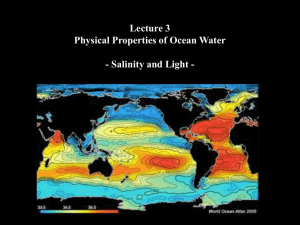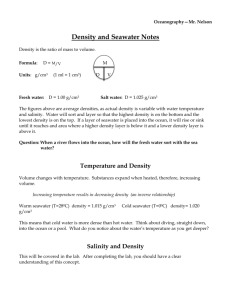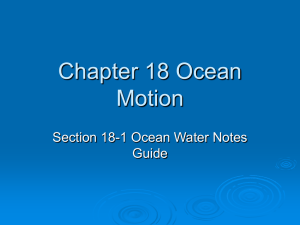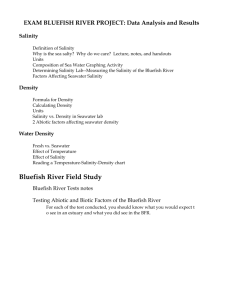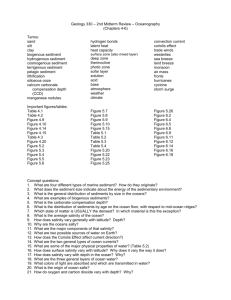Chapter 5
advertisement
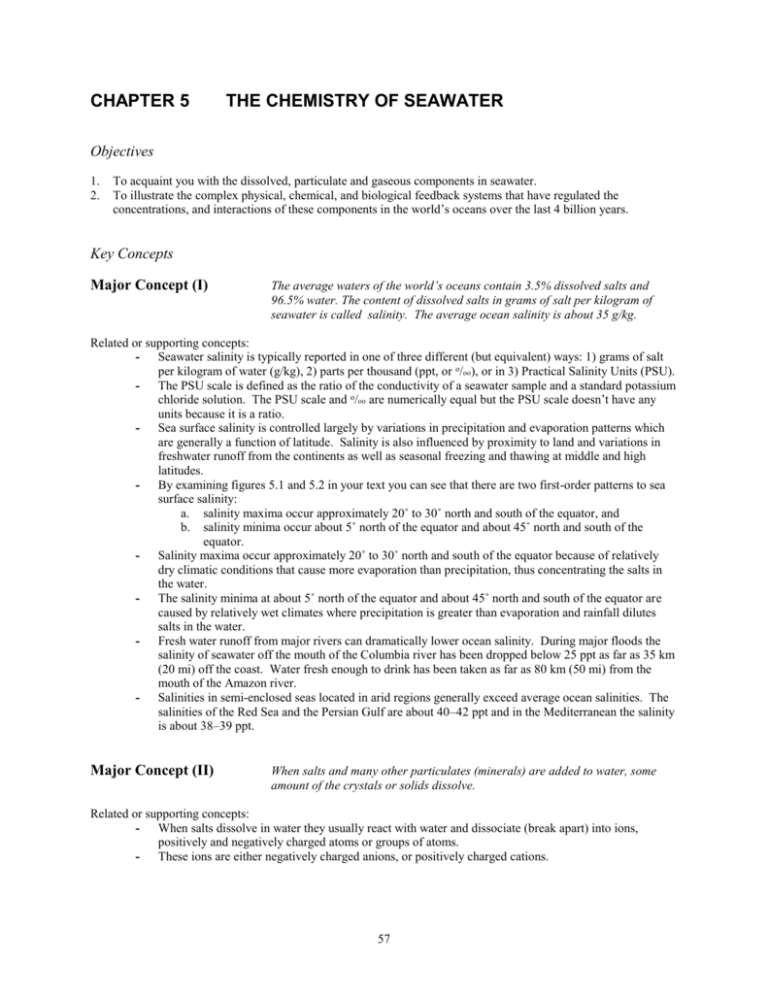
CHAPTER 5 THE CHEMISTRY OF SEAWATER Objectives 1. 2. To acquaint you with the dissolved, particulate and gaseous components in seawater. To illustrate the complex physical, chemical, and biological feedback systems that have regulated the concentrations, and interactions of these components in the world’s oceans over the last 4 billion years. Key Concepts Major Concept (I) The average waters of the world’s oceans contain 3.5% dissolved salts and 96.5% water. The content of dissolved salts in grams of salt per kilogram of seawater is called salinity. The average ocean salinity is about 35 g/kg. Related or supporting concepts: - Seawater salinity is typically reported in one of three different (but equivalent) ways: 1) grams of salt per kilogram of water (g/kg), 2) parts per thousand (ppt, or o/oo), or in 3) Practical Salinity Units (PSU). - The PSU scale is defined as the ratio of the conductivity of a seawater sample and a standard potassium chloride solution. The PSU scale and o/oo are numerically equal but the PSU scale doesn’t have any units because it is a ratio. - Sea surface salinity is controlled largely by variations in precipitation and evaporation patterns which are generally a function of latitude. Salinity is also influenced by proximity to land and variations in freshwater runoff from the continents as well as seasonal freezing and thawing at middle and high latitudes. - By examining figures 5.1 and 5.2 in your text you can see that there are two first-order patterns to sea surface salinity: a. salinity maxima occur approximately 20˚ to 30˚ north and south of the equator, and b. salinity minima occur about 5˚ north of the equator and about 45˚ north and south of the equator. - Salinity maxima occur approximately 20˚ to 30˚ north and south of the equator because of relatively dry climatic conditions that cause more evaporation than precipitation, thus concentrating the salts in the water. - The salinity minima at about 5˚ north of the equator and about 45˚ north and south of the equator are caused by relatively wet climates where precipitation is greater than evaporation and rainfall dilutes salts in the water. - Fresh water runoff from major rivers can dramatically lower ocean salinity. During major floods the salinity of seawater off the mouth of the Columbia river has been dropped below 25 ppt as far as 35 km (20 mi) off the coast. Water fresh enough to drink has been taken as far as 80 km (50 mi) from the mouth of the Amazon river. - Salinities in semi-enclosed seas located in arid regions generally exceed average ocean salinities. The salinities of the Red Sea and the Persian Gulf are about 40–42 ppt and in the Mediterranean the salinity is about 38–39 ppt. Major Concept (II) When salts and many other particulates (minerals) are added to water, some amount of the crystals or solids dissolve. Related or supporting concepts: - When salts dissolve in water they usually react with water and dissociate (break apart) into ions, positively and negatively charged atoms or groups of atoms. - These ions are either negatively charged anions, or positively charged cations. 57 - - Six major ions make up > 99% of the salts dissolved in seawater: four cations--sodium (Na+), magnesium (Mg2+), calcium (Ca2+), and potassium (K+); and two anions--chloride (Cl-) and sulphate (SO42-). These six ions and the five next most common ones make up the major constituents of seawater and comprise 99.99% of dissolved materials. Note that our ordinary table salt, sodium chloride, makes up 86% of dissolved ions in seawater. Many other elements are dissolved in seawater in concentrations less than one part per million (ppm) and we call them trace elements. Because of the intricate buffering relationships in the oceans combined with mixing and currents over long geological time periods, the major constituents (ions) of seawater have very constant ratios to one another, and are therefore, also termed conservative constituents. Other trace elements, dissolved gases, and nutrients change concentrations dramatically, depending on season or locale and biological processes, and are termed non conservative constituents (I bet you had already guessed that). Major Concept (III) The source of salts in the sea is from the weathering, erosion, and dissolution of the rocks that make up the earth’s crust, initially they are primarily from the igneous rocks of the crust as the crust and mantle degassed and differentiated. Related or supporting concepts: - Today’s anions and cations are delivered to the world’s oceans by rain and river waters from very diverse sources: weathering of igneous, metamorphic, and sedimentary rocks, acid leaching of sediments and soils, and from volcanic eruptions and gaseous emanations. - A newly discovered source of anions and cations is hydrothermal vents along mid-ocean ridges. Major Concept (IV) The total amount of dissolved salts in the world oceans can be calculated at a mind- boggling 5 10 22 grams (at 36 ppt). Each year we estimate that some 2.5 10 15 grams of salt are added to the oceans. Yet all of the geological evidence available, and our recent calculations indicate the salt content of the oceans has been very stable for perhaps 1.5 billion years or more. Related or supporting concepts: - A system that regulates or matches the inputs and outputs of salts to and from the world’s oceans must exist. More importantly, salt must be removed from the ocean each year to approximately match the salts added. Where does it go to? - Salts are removed from the world’s oceans in many ways. One major pathway is in tropicalsubtropical areas where seawater evaporates, salt-rich brines form, and then salts precipitate to form evaporites. - Minor removals of salts occur through chemical reactions that form insoluble products, biological removal in excretion products, shell and skeletal formation, and plant tissues; along with the burial and preservation of these hard parts in the sediments. - Clays may also buffer salts (along with many other reactions, such as pH) by adsorption or adherence of salts to charged surfaces and by chemically exchanging ions within the clay lattice. - More recently, we have discovered that a tremendous amount of chemical exchange goes on at spreading centers and hot spots where heated seawater reacts with newly formed oceanic crust. - In the final analysis, the most important removal pathway of all dissolved elements in seawater is the adsorption onto particles that are incorporated into the sedimentary layers deposited on the sea floor. In this way their liberation, or return to the ocean, may be linked to plate tectonic recycling time scales. 58 Major Concept (V) Although the major constituents of seawater have likely remained in constant proportions for at least 1.5 billion years, they are recycled through the oceans at vastly different rates, with residence times that range from hundreds of years to tens of millions of years. Related or supporting concepts: - The average time that a substance remains in solution in the ocean is called its residence time. - Aluminum and iron have very short residence times because they react chemically with other substances to form insoluble particals that are added to the sediment. - Sodium, chloride, potassium, and magnesium have very long residence times because they do not react chemically to form solids and they are not extracted from the water by biological processes. - Four basic calculations allow us to estimate the residence time of any component in the oceanic system, however, we must know four additional items: a. the total mass of the particular ion in seawater, knowing the ion concentration per kilogram of seawater, and the total estimated mass of the oceans. b. the input rate of the ion in kg/yr, knowing the ionic concentration in kg/km3 of river water and the river discharge in km3/yr. c. We know the input rate must equal the output rate! d. Therefore the residence time equals the total mass of the ion in the ocean at any time divided by the output rate (see table 5.4 for average residence times of ions). Major Concept (VI) In the open, well-mixed ocean waters, the ratio of one major ionic constituent to another is constant regardless of the total salinity measurement. This is called the principle of constant proportion. Related or supporting concepts: - Once again, the constancy of these ratios holds true only for the major constituent ions, and only in open ocean waters. - From this concept, if we know the ratios of major constituents to one another, and can measure the concentration of one of these ions, we can estimate the concentration of all of the others and provide a reasonable estimate of salinity at that location. This was commonly done by measuring the concentration of the chloride anion (the chlorinity of the water). - Salinity and chlorinity are related by: Salinity (o/oo) = 1.80655 Chlorinity (o/oo) or So/oo = 1.80655 Clo/oo - Today we calculate salinity using the conductive properties of seawater, calibrating the results against chloride content and correcting for changes in temperature. Seawater conducts electricity easily because is contains dissolved salts. The higher the salinity, the greater the conductivity of the water. Salinity is determined from seawater conductivity measured with an instrument called a salinometer. Conductivity depends on both salinity and temperature so salinometer measurements have to be corrected for the temperature of the water. Major Concept (VII) Many gases move readily across the air-sea interface. Three gases are particularly critical to life on earth and the physical and chemical balances within the ocean realm. These are nitrogen (N2), oxygen (O2), and carbon dioxide (CO2). These gases comprise more than 99% of the gases in the atmosphere and the oceans. 59 Related or supporting concepts: - Dissolved gases are mixed to all depths in the oceans. - Gases dissolve more readily in cold water, water with low salinity, and water under pressure. Conversely, warm waters (similar to warm sodas) can hold less gas. Very saline water has less gas. Deep, cold ocean water commonly contains relatively higher concentrations of dissolved gases. - If we slowly add gas to a liquid we reach a point where we cannot add more gas without some of the gas being released from the solution simultaneously. The concentration level where the fluid will neither gain nor lose gas is the saturation value for that gas and is dependent on salinity, temperature, and pressure. - In the world oceans, carbon dioxide concentration is controlled primarily by a variety of specific chemical reactions. Oxygen concentration is controlled by photosynthetic production of O 2 by plants, and the uptake of O2 and release of CO2 by animals during respiration and decay of organic matter. - Photosynthesis only occurs in well-lit surface waters, while CO2 production (respiration and decay) occurs at all depths. The depth where plant photosynthesis O2 production balances the CO2 produced in respiration by plants is the compensation depth. Above this depth more O 2 is produced, below it more CO2. - Oxygen concentrations can range from nearly zero in stagnant bottom waters of silled basins and deep fjords to supersaturated values (up to 158%) in highly productive surface water. Bottom water that is stripped of oxygen is called anoxic. Major Concept (VIII) In a sequence of elegant and reversible interactions, carbon dioxide and water couple to form a stable buffering system that controls the pH of the world’s oceans. Related or supporting concepts: - When carbon dioxide dissolves in seawater, it really enters into a sequence of reversible chemical reactions with carbon dioxide and H2O on one end, carbonic acid (H2CO3), bicarbonate (HCO3-) and hydrogen ions (H+), and finally carbonate (CO32-) and two hydrogen ions (2H+). CO2 + H2O H2CO3 HCO3- + H+ CO32- + 2H+ - When CO2 buffers oceanic pH, it helps to maintain oceanic pH ranges from 7.5–8.5 (i.e., slightly basic or alkaline); the average ocean pH is about 7.8 (see fig. 5.7). The pH of surface water can be as high as 8.5 if the water is warm and high rates of photosynthesis are extracting large amounts of CO2 from the water. Major Concept (IX) Tremendous amounts of carbon dioxide and oxygen are cycled through the world’s oceans each year. Related or supporting concepts: - The annual ocean uptake of carbon (in the form of carbon dioxide) is calculated at 2.5 billion metric tons per year. - The rate at which the oceans absorb carbon dioxide is controlled by water temperature, pH, salinity, chemistry, and geological and biological processes. - CO2 gets transferred from the surface to deep ocean waters and eventually is fixed in marine sediments as organisms remove calcium carbonate (CaCO3) to produce skeletal material. 60 Major Concept (X) The oceans have played one of the critical roles in regulating the free oxygen concentration in the earth’s atmosphere for nearly 3.5 billion years. Related or supporting concepts: - Photosynthesis releases oxygen to the ocean and atmosphere. In excess of respiration, some 300 million metric tons per year are released that would eventually result in an increase in O2 concentrations in the oceans and atmosphere. However, the excess oxygen is consumed chemically during oxidation of exposed surface sediments and animal respiration, and decomposition of organic compounds. Major Concept (XI) Two other important groups of compounds in the world’s oceans are ions needed in plant or animal growth (nutrients); and an enormous variety of trace minerals and organic components that range from metals to protein-based compounds to fats and other complex lipids. Related or supporting concepts: - The nutrients needed for plant growth in the oceans include nitrate (NO 3-), phosphate (PO43-), and silicate (SiO4-). - Silicate is used to form silica (SiO2), the material that forms the hard outer wall of single-celled plantlike organisms called diatoms as well as the skeletal parts of some protozoans. - These nutrients are brought to the oceans by freshwater runoff from the continents. - These nutrients are generally present in very low concentrations in seawater. - The concentration of nutrients in seawater is cyclical. Nutrient concentration decreases as increasing biological productivity removes nutrients. Concentrations increase when populations decline and death and decay return nutrients to the water. - Nutrients are non-conservative. They do not have constant relative abundance. - Some organic components are used directly by marine organisms and are incorporated into their systems. - Organic material can also be incorporated into the sediment where it may eventually form deposits of oil and gas. - In surface water that has very high plant and animal population density the presence of organic decay products can color the water green-yellow. - The incorporation of soluble organic material into glacial ice in Antarctic ice shelves can from green ice (see the box related to this in chapter 4 of your text). Major Concept (XII) As a result of the tremendous dissolving power of seawater, the oceans represent the major repository of many chemical resources used in our complex, high-tech society. Related or supporting concepts: - 30% of the world’s salt is extracted from seawater. Salt can be concentrated by evaporation at low latitudes, or by freezing at high latitudes. - 60% of the world’s magnesium comes from the sea, along with 70% of the bromine. - Future technologies may be able to take advantage of extremely valuable trace element concentrations in seawater that are not currently economical to recover. Two examples include gold and uranium which have estimated dissolved concentrations of 10 million tons and 4 billion tons in seawater respectively. - Conversely, fresh water can be produced from seawater by the general process of desalination. There are several popular processes, but most require large amounts of energy to produce viable quantities of fresh water. These include: a. methods that require changes of state (freezing or evaporation), b. ion exchange processes, and 61 - - c. electrodialysis and reverse osmosis using semipermeable membranes. Ion exchange systems work best with low salinity water. One disadvantage is that the resins used in the ion exchange columns need to be replaced frequently. Electrodialysis uses an electric field to move ions out of solution. It is most effective with relatively low-salinity brackish water. Reverse osmosis works by applying pressure to seawater and forcing water molecules through a semipermeable membrane, leaving behind salt ions and other impurities. Reverse osmosis requires a pressure of at least 24.5 atmospheres and should be as high as 101.5 atmospheres to produce a reasonable rate of freshwater production. Reverse osmosis is the most popular and rapidly growing form of desalination. Advantages of reverse osmosis include: a. you do not need to use energy to heat the water in the treatment process, b. there is no thermal pollution from the discharged water, and c. unwanted contaminants including pesticides, bacteria, and come chemical compounds are removed. Disadvantages of reverse osmosis include: a. the return of high salinity waste water, and b. the high cost associated with the process. Twelve percent of the world’s desalination capacity is produced in the Americas. Most of that capacity is located in the Caribbean and Florida. The nation’s largest reverse osmosis plant is located in Santa Barbara, California. It can produce roughly 26 million liters (7 million gallons) of fresh water per day. There are more than 7500 desalination plants operating around the world. Sixty percent of them are located on the Arabian Peninsula and in the Middle East. Matching Key Terms with Major Concepts At the end of the chapter in the textbook is a list of key terms. You should be able to match each of these with one of the previously listed major concepts. To test your ability, try to match the following key terms with the number (IXII) of the appropriate major concept identified in this section: salinity major constituent pH buffer supersaturation ion exchange halogens nutrients adsorption electrodialysis compensation depth cation conservative ion desalination anion photosynthesis evaporite chlorinity residence time ion anoxic salinometer Test Your Recall Answer the following questions to test your understanding FILL IN THE BLANK 1. Oceanographers measure seawater's salt content or ________________________ in grams of salt per kilogram of seawater. 2. When salts are added to water, the salts __________________________. 3. Sodium and chloride ions account for ______________ % of the salt ions present in seawater. 62 4. ____________________ ___________________________ are elements present in seawater at concentrations less than 1 ppm. 5. The major constituents of open ocean seawater do not change their ratios with respect to one another and have been termed ___________________________________. 6. The original sources of the salts in the world’s oceans are the ______________________ and ___________________________ of the earth. 7. _______________________________ are sedimentary deposits of salt left behind after a portion of the sea has undergone tremendous evaporation. 8. The most important process for the removal of elements from seawater is the __________________________ of ions onto fine sedimentary particles. 9. The average time that an ion remains in solution in seawater is called its __________________________ __________________. 10. The _______________ between the amounts of major ions in open ocean water are __________________________. 11. ______________________ is defined as the quantity of silver required to remove all of the halogens from 0.3285 kilograms of seawater. 12. The amount of gas that can be held in solution without causing the solution to either gain or lose gas is called the ______________________ ________________. 13. Water is termed _____________________ when it has been stripped of dissolved oxygen. 14. Carbon dioxide acts as a _____________________ to control pH in the ocean. 15. Ions required for plant growth are known as __________________________. 16. _____________________________ is the process of obtaining fresh water from salt water. 17. __________________________ is the movement of water across a semipermeable membrane. 18. The ______ of seawater is generally between 7.5 and 8.5. 19. Non oxygen-using bacteria are called ___________________________. 20. When the concentration of a substance in water is greater than the saturation level for that substance, it is said to be __________________________________________. TRUE - FALSE 1. The salinity of surface seawater is associated with latitude. 2. An ion with a negative charge is called a cation. 3. The most abundant salts in today’s rivers are the least abundant ones in ocean water. 4. Iron has one of the longest residence times of ions in the oceans. 5. Chloride has a residence time of about 80 million years. 6. The ratios between minor constituents in seawater are constant. 7. Animals produce oxygen and use carbon dioxide in the process known as photosynthesis. 8. Oxygen-using or anaerobic bacteria are often found at depth in deep, stagnant ocean basins. 9. The concentration of carbon dioxide in the world’s oceans is controlled only by the biologically governed interactions of photosynthesis, respiration, and decay. 10. Oxygen acts as a buffer of pH in the oceans. 11. Gold and silver can be economically retrieved from seawater today. 12. The oxygen minimum zone is at a depth of about 800 m. 13. The pH of seawater varies by only about 1 pH unit. 14. Decomposition is more important than respiration for removing oxygen from the water at shallow depths. 63 15. 16. 17. 18. 19. 20. In cold climates, salt can be extracted from seawater by freezing in shallow ponds. Tests have been conducted to mine uranium from seawater. Electrodialysis works best in high salinity water. The saturation value of gases in seawater generally increases with decreasing temperature. The practicality of desalination is determined by cost and need. Reverse osmosis can produce fresh water. MULTIPLE CHOICE 1. Salts commercially extracted from seawater today are a. potassium chloride, gold, and silver. b. sodium chloride, uranium, and phosphorus. c. sodium chloride, magnesium, and bromine. d. bromine, fluorine, and cosmoline. e. none of the above. 2. The salinity of average open ocean seawater is a. 3.5 ppt. b. 35 ppt. c. 35%. d. 0.35%. e. 3.5 ppm. 3. Trace elements are present in seawater at concentrations less than: a. 1% b. 1 ppt c. 1 ppm d. 1 ppb e. 1 obs 4. The salt in the oceans comes from a. rainfall. b. rivers. c. volcanic eruptions. d. all of the above. e. none of the above. 5. Which of the following has the shortest residence time in the oceans? a. chloride b. magnesium c. potassium d. sodium e. iron 6. We can compute salinity if we measure a. alkalinity. b. chlorinity. c. pH. d. viscosity. e. productivity. 7. The oxygen minimum depth occurs at about a. 800 meters. b. 2500 meters. c. 10 meters. d. 4000 meters. e. 200 meters. 8. Normal pH of seawater is approximately a. 1. b. 4. c. 8. d. 12. 64 e. 14. 65 9. Which of the following nutrients has the highest concentration in seawater? a. phosphorus b. silicon c. oxygen d. nitrogen e. carbon dioxide 10. The movement of water across a semipermeable membrane is called a. evaporation. b. ion exchange. c. dissolution. d. respiration. e. osmosis. 11. Which of these ions is not a major constituent of seawater? a. sulfate b. sodium c. potassium d. nitrite e. chloride 12. Salts can be removed from seawater by a. the formation of evaporites. b. adherence of ions onto sediment particles. c. chemical reactions that form insoluble precipitates. d. removal by organisms to build hard parts. e. all of the above. 13. The most common ion dissolved in river water is a. chloride. b. carbonate. c. sodium. d. phosphate. e. nitrate. 14. Which of the following is/are true of respiration a. it consumes oxygen and produces carbon dioxide and energy. b. it consumes carbon dioxide and produces oxygen and energy. c. it is restricted to the photic zone. d. a and c above. e. b and c above. 15. About _____ % of the world’s supply of salt is extracted from seawater. a. 5 b. 15 c. 30 d. 20 e. 1 16. About _____ % of the world’s supply of magnesium is extracted from seawater. a. 30 b. 60 c. 10 d. 45 e. 80 17. About _____ % of the world’s supply of bromine is extracted from seawater. a. 25 b. 35 c. 90 d. 70 e. 15 66 18. Which of the following organic substances is found in seawater? a. proteins b. carbohydrates c. lipids d. fats e. all of the above and more 19. The concentration of carbon dioxide in the upper 1000 m of seawater a. decreases with increasing depth. b. increases with increasing depth. c. is relatively constant. d. has a profile that is similar to that of oxygen. e. a and d above. 20. Salinity can be calculated from chlorinity by multiplying by about a. 3.56. b. 10.23. c. 1.81. d. 5.69. e. 0.45. Study Problems 1. Assuming that there are 1.4 1021 kg of water in the oceans, use table 5.2 to calculate how many tons (there are roughly 907 kg/ton) of the following elements there are dissolved in seawater. a. copper b. aluminum c. mercury d. radium e. tin 2. If the chlorinity of a seawater sample is 19.7614 g/kg, what is the salinity? 3. If the concentration of chloride in a seawater sample is 17.60 g/kg, what is the concentration of each of the following in g/kg? a. sulfate b. bicarbonate c. sodium d. calcium Visual Aids: Test Your Understanding of the Figures 1. Examine figure 5.1 carefully. Convince yourself that you can explain the pattern of surface ocean salinity by the pattern of evaporation minus precipitation. 2. Look over figure 5.6 carefully, review your notes, and read the accompanying chapter text. Why does CO 2 concentration increase with depth, while O2 concentrations decrease? What would make O2 increase again at great depth? Answer Key for Key Terms and Test Your Recall KEY TERMS salinity (I) major constituent (II) pH (VIII) buffer (VIII) supersaturation (VII) ion exchange (XII) adsorption (IV) electrodialysis (XII) compensation depth (VII) cation (II) conservative ion (II) desalination (XII) 67 photosynthesis (VII) evaporite (IV) chlorinity (VI) residence time (V) ion (II) anoxic (VII) halogens (VI) nutrients (XI) FILL IN THE BLANK 1. salinity 4. trace elements 7. evaporites 10. ratios, constant 13. anoxic 16. desalination 19. anaerobic anion (II) salinometer (VI) 2. dissolve 5. conservative 8. adsorption 11. chlorinity 14. buffer 17. osmosis 20. supersaturated 3. 86 6. crust, interior 9. residence time 12. saturation value 15. nutrients 18. pH TRUE - FALSE 1.T 2.F 3.T 4.F 5.T 6.F 7.F 8.F 9.F 10.F 11.F 12.T 13.T 14.F 15.T 16.T 17.F 18.T 19.T 20.T MULTIPLE CHOICE 1.c 2.b 3.c 4.d 5.e 6.b 7.a 8.c 9.b 10.e 11.d 12.e 13.b 14.a 15.c 16.b 17.d 18.e 19.b 20.c STUDY PROBLEMS 1. a. 386 million b. 834 million c. 1.54 million d. 108 e. 772 thousand 2. 36.70 g/kg 3. a. 2.46 b. 0.13 c. 9.79 d. 0.37 68





